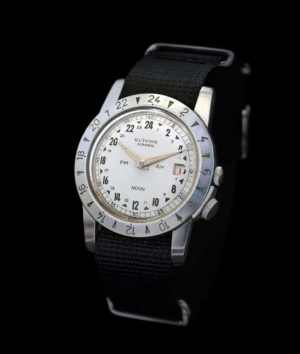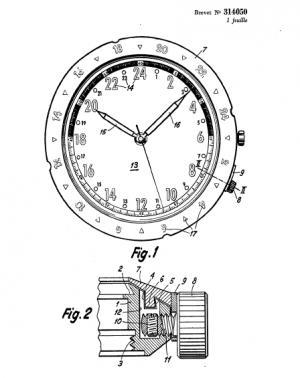Glycine Airman: Difference between revisions
| Line 10: | Line 10: | ||
[[File:Glycine blueprint.png|thumb]] | [[File:Glycine blueprint.png|thumb]] | ||
Looking at the design evolution of the Airman, it is clear to see that the very first release of the watch was a test as a lot of elements would change a few months later. The AM/PM written on the dial to allow easier reading of the time of day would go, as would Noon written at the bottom of the dial. The dauphine hands would be changed in favor of pencil/syringe hands and the hour markers would become uniform in size rather than emphasize the even hours. The rotating bezel would stay mostly the same, as would its locking mechanism. | Looking at the design evolution of the Airman, it is clear to see that the very first release of the watch was a test as a lot of elements would change a few months later. The AM/PM written on the dial to allow easier reading of the time of day would go, as would Noon written at the bottom of the dial. The dauphine hands would be changed in favor of pencil/syringe hands and the hour markers would become uniform in size rather than emphasize the even hours. The rotating bezel would stay mostly the same, as would its locking mechanism. | ||
The idea of a rotating bezel to act as reference device for checking the time was beginning to catch on in the early 1950s. Also releasing in 1953, the [[Rolex Turn-o-graph]] was the first regular production Rolex to use a rotating bezel to mark time, and it would serve as inspiration for the [[Rolex Submariner]] and the [[Rolex GMT-Master]]. What makes the Airman bezel unique was its locking mechanism. The bezel was not ratcheted so unique time zones that were in-between hourly intervals could be measured, so Glycine added a thumbscrew at 4 o'clock to lock the bezel in place once set. | |||
==Links== | ==Links== | ||
Revision as of 01:12, 17 April 2020
Glycine Airman

In 1953, Samuel W. Glur, a sales director for Montres Altus S.A., was on-board a Thai Airways flight from Bangkok to Calcutta (now Kolkata). This was a different time and Samuel was able to make his way into the cockpit to strike up a conversation with the Captain about his wristwatch needs. The idea of designing a watch specifically for aviation use was still in its infancy in 1953, even though aviation was now 40 odd years old.
The Cartier that Santos DuMont wore on his first flight was practically identical to other dress watches of the era and the watches that pilot's had worn during World War II might have been larger and more legible, but they were hardly specialized tools. The Breitling Navitimer, released in 1952, was a technical marvel which allowed pilots to make quick calculations thanks to its rotating slide rule bezel, but only one timezone could be read at one time. In an age of propeller driven planes, that was fine but the jet age was soaring into view. Planes were flying faster and further than ever before and pilots needed a tool to help them.
What the Captain said he wanted was an automatic, waterproof watch with calendar function and a 24 hour dial with centralized hour, minute and second hands with a rotating 24 hour bezel. After touching down in India, Samuel Glur wrote to his friend Charles Hertig about the potential market for a dedicated pilots watch. These specifications would be turned into a real watch just a few months later, the Glycine Airman.
Evolution of the Airman

Looking at the design evolution of the Airman, it is clear to see that the very first release of the watch was a test as a lot of elements would change a few months later. The AM/PM written on the dial to allow easier reading of the time of day would go, as would Noon written at the bottom of the dial. The dauphine hands would be changed in favor of pencil/syringe hands and the hour markers would become uniform in size rather than emphasize the even hours. The rotating bezel would stay mostly the same, as would its locking mechanism.
The idea of a rotating bezel to act as reference device for checking the time was beginning to catch on in the early 1950s. Also releasing in 1953, the Rolex Turn-o-graph was the first regular production Rolex to use a rotating bezel to mark time, and it would serve as inspiration for the Rolex Submariner and the Rolex GMT-Master. What makes the Airman bezel unique was its locking mechanism. The bezel was not ratcheted so unique time zones that were in-between hourly intervals could be measured, so Glycine added a thumbscrew at 4 o'clock to lock the bezel in place once set.
